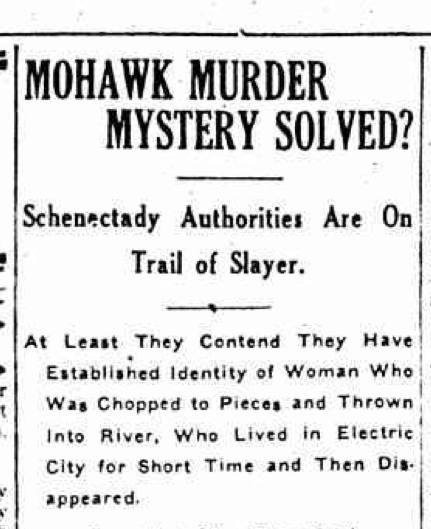
Schenectady police continued to work the case of the mysterious torso that was discovered in the Mohawk River in the summer of 1914. (Her head turned up on the Fourth of July.) Detectives thought they had found a clue on June 26, when they found a bloodstained shirtwaist near Ballston Lake. As with the sharp-eyed Claude Hanlon, who thought nothing of a stranger with a burlap bag and a chunk of concrete, one L.M. Young discovered pieces of women’s clothing soaked in blood lying in the roadway, tossed them over the fence, and paid no further attention until reading of a similar discovery several weeks later in Schenectady.
Police thought perhaps the victim was related to the circus, which had just been in town. They thought perhaps it was this woman or that woman; it’s a bit alarming just how many women were apparently unaccounted for in 1914, just waiting to be named as murder victims.
Then, on July 14, police announced that the victim was Eva Kenska, of New York City, a “Russian Pole” who had come to Schenectady in May, worked in a hotel and lived with a man in a small shack along the railroad tracks. The woman disappeared a few days later, and the man was seen around the city selling off household items, including “a large rug, showing what the police declare to be blood stains, and a trunk of woman’s clothing all measuring twenty-five inches about the waist, identical with the measurement of the torso.” Numerous other clues, including pieces of concrete in the yard “similar to that tied to the torso, and also a number of empty sacks, identical with those in which the portion of the body was tied up,” as well as the “peculiar life” of the male companion, who claimed to be a blacksmith but who sought no work, convinced police they finally had their victim and their suspect, and they went to the morning papers with the name Eva Kenska.
Then they went to the evening papers, on the same day, to say “never mind.” “The victim was believed to be Eva Kenska, who came here with Karol Devatchenko from New York. They lived together for a while at a roadhouse and then disappeared. The police to-day learned that the woman accompanied the man back to New York and could not have been the murder victim.”
Some time later, they thought again, and determined that perhaps Eva Kenska was their victim after all. There was apparently some form of love triangle between Kenska, her husband, and Devatchenko. Kenska was apparently not seen again. In October, a suicide was discovered in the woods in Hastings, and in his pockets were only two things: a street car transfer, and a marked article about the murder. Later that month, mention is made that Kenska’s husband came to Schenectady to collect her effects, including a dog that figured in the case. While in his care, the dog bit a mailman, making the last bit of news associated with this case.

Leave a Reply